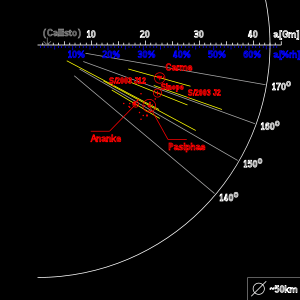Pasiphae (moon)
 | |
| Discovery | |
|---|---|
| Discovered by | P. J. Melotte |
| Discovery date | January 27, 1908 |
| Orbital characteristics | |
| Periapsis | 16,980,250 km[1] |
| Apoapsis | 31,209,300 km[1] |
Mean orbit radius | 24,094,770 km[1] |
| Eccentricity | 0.2953[1] |
| 764.082032 d (2.092 a)[1] | |
Average orbital speed | 2.242 km/s |
| Inclination |
145.24° (to the ecliptic) 143.04° (to Jupiter's equator)[1] |
| Satellite of | Jupiter |
| Physical characteristics | |
Mean radius |
20 km[2] 18 km[3] |
| ~11,300 km² | |
| Volume | ~113,000 km³ |
| Mass | 3.0×1017 kg |
Mean density | 2.6 g/cm³ (assumed)[2] |
| ~0.022 m/s2 (0.002 g) | |
| ~0.036 km/s | |
| Albedo |
0.04 (assumed)[2] 0.10[3] |
| Temperature | ~124 K |
|
| |
Pasiphae (/pəˈsɪfə.iː/ pə-SIF-ə-ee;[4] Greek: Πασιφάη; formerly Pasiphaë)[5] is a retrograde irregular satellite of Jupiter. It was discovered in 1908 by Philibert Jacques Melotte[6][7] and later named after the mythological Pasiphaë, wife of Minos and mother of the Minotaur from Greek legend.
It was first spotted on a plate taken at the Royal Greenwich Observatory on the night of February 28, 1908. Inspection of previous plates found it as far back as January 27. It received the provisional designation 1908 CJ, as it was not clear whether it was an asteroid or a moon of Jupiter. The recognition of the latter case came by April 10.[8]
Pasiphae did not receive its present name until 1975;[9] before then, it was simply known as Jupiter VIII. It was sometimes called "Poseidon"[10] between 1955 and 1975.
Orbit

Pasiphae orbits Jupiter on a high eccentricity and high inclination retrograde orbit. It gives its name to the Pasiphae group, irregular retrograde moons orbiting Jupiter at distances ranging between 22.8 and 24.1 million km, and with inclinations ranging between 144.5° and 158.3°.[11] The orbital elements are as of January 2000.[1] They are continuously changing due to solar and planetary perturbations. The diagram illustrates its orbit in relation to other retrograde irregular satellites of Jupiter. The eccentricity of selected orbits is represented by the yellow segments (extending from the pericentre to the apocentre). The outermost regular satellite Callisto is located for reference.
Pasiphae is also known to be in a secular resonance with Jupiter (tying the longitude of its perijove with the longitude of perihelion of Jupiter).[12]
Physical characteristics
With diameter estimated at 58 km Pasiphae is the largest retrograde and third largest irregular satellite after Himalia and Elara.
Spectroscopical measurements in infrared indicate that Pasiphae is a spectrally featureless object, consistent with the suspected asteroidal origin of the object. Pasiphae is believed to be a fragment from a captured asteroid along with other Pasiphae group satellites.[13][14]
In the visual spectrum the satellite appears grey (colour indices B-V=0.74, R-V=0.38) similar to C-type asteroids.[15]
See also
References
- 1 2 3 4 5 6 7 Jacobson, R. A. (2000). "The Orbits of the Outer Jovian Satellites". Astronomical Journal. 120 (5): 2679–2686. Bibcode:2000AJ....120.2679J. doi:10.1086/316817.
- 1 2 3 "Planetary Satellite Physical Parameters". JPL (Solar System Dynamics). 2008-10-24. Retrieved 2008-12-12.
- 1 2 Williams, Dr. David R. (2007-11-23). "Jovian Satellite Fact Sheet". NASA (National Space Science Data Center). Retrieved 2008-12-12.
- ↑ http://dictionary.reference.com/browse/pasiphae?r=75
- ↑ http://planetarynames.wr.usgs.gov/Page/Planets
- ↑ Melotte, P. J. (1908). "Note on the Newly Discovered Eighth Satellite of Jupiter, Photographed at the Royal Observatory, Greenwich". Monthly Notices of the Royal Astronomical Society. 68 (6): 456–457. Bibcode:1908MNRAS..68..456.. doi:10.1093/mnras/68.6.456.
- ↑ Perrine, C. D.; Perrine, C. D. (June 1908). "Recent Observations of the Moving Object Near Jupiter, Discovered at Greenwich by Mr. J. Melotte". Harvard College Observatory Bulletin. 20: 184–185. Bibcode:1908PASP...20..184M. doi:10.1086/121815.
- ↑ Cowell, P. H. (1908). "Note on the Discovery of a Moving Object Near Jupiter". Monthly Notices of the Royal Astronomical Society. 68: 373. Bibcode:1908MNRAS..68..373.. doi:10.1093/mnras/68.5.373.
- ↑ IAUC 2846: Satellites of Jupiter 1974 October 7 (naming the moon)
- ↑ Payne-Gaposchkin, Cecilia; Katherine Haramundanis (1970). Introduction to Astronomy. Englewood Cliffs, N.J.: Prentice-Hall. ISBN 0-134-78107-4.
- ↑ Sheppard, S. S.; Jewitt, D. C.; and Porco, C. C.; Jupiter's Outer Satellites and Trojans, in Jupiter: The Planet, Satellites and Magnetosphere, edited by Fran Bagenal, Timothy E. Dowling, and William B. McKinnon, Cambridge Planetary Science, Vol. 1, Cambridge, UK: Cambridge University Press, ISBN 0-521-81808-7, 2004, pp. 263-280
- ↑ Nesvorný, D.; Beaugé, C.; Dones, L. (2004). "Collisional Origin of Families of Irregular Satellites". The Astronomical Journal. 127 (3): 1768–1783. Bibcode:2004AJ....127.1768N. doi:10.1086/382099.
- ↑ Brown, M. E. (2000). "Near-Infrared Spectroscopy of Centaurs and Irregular Satellites". The Astronomical Journal. The American Astronomical Society. 119 (2): 977–983. Bibcode:2000AJ....119..977B. doi:10.1086/301202.
- ↑ Sheppard, S. S.; and Jewitt, D. C.; An Abundant Population of Small Irregular Satellites Around Jupiter, Nature, Vol. 423 (May 2003), pp. 261-263
- ↑ Grav, T.; Holman, M. J.; Gladman, B. J.; and Aksnes, K.; Photometric Survey of the Irregular Satellites, Icarus, Vol. 166 (2003), pp. 33-45
External links
- Pasiphae Profile by NASA's Solar System Exploration
- David Jewitt pages
- Scott Sheppard pages
- MPC: Natural Satellites Ephemeris Service